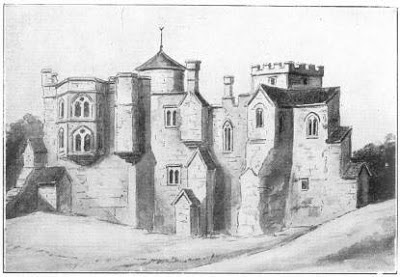Tuesday, February 19, 2013
Today's research snippet. By the time I got to Woodstock...
A few notes on the royal palace at Woodstock:
Woodstock in Oxfordshire had been a royal residence for hunting, relaxation and gatherings since the time of the Saxon kings, but it was further developed in the reigns of Henry I and more especially Henry II who turned it into a 'Sicilian-style retreat with internconnecting pools."
In 1110, Henry I built a stone wall around the park of Woodstock in order to contain his collection of animals including lions, leopards, lynxes, camels and a porcupine.
Henry II extended the buildings at Woodstock and rolled out the programme to include nearby Everswell. He intended the additional buildings to accommodate his household when he visited, and for Everswell to be a residence for his mistress Rosamund de Clifford, so that she would be nearby when the court came to Woodstock, but discreetly separate.
The remains of the palace of Woodstock were destroyed around the time of the building of Blenheim Palace when they were razed to make way for landscaped gardens. Any remnants were then lost under the ornamental lake. Sir John Vanbrugh wanted to keep the remains of Woodstock, but Lady Marlborough, his patroness was having none of it and and in the end he had to raze them.
In 1163, Woodstock was the site where Henry II took the homage of the King of Scotland and various Welsh princes and other nobles. In 1178, he knighted his son Geoffrey here.
There were 2 complexes of buildings as well as the settlement of New Woodstock which grew up on the edge of the forest. The first complex contained the buildings of the actual palace and are the ones levelled by Vanbrugh. Antiquarian John Aubrey saw it in 1672 before it came down and says that there was a manor house, a chapel still retaining red and blue wall coverings, and a hall with pillars and semi-circular arcading.
The second complex of buildings was at Everswell and was where Rosamund's dwelling was located (according to architectural historian Thomas Beaumont James). The layout was very unusual for England . John Aubrey made a sketch plan which shows a gatehouse and other buildings. The sketch also shows a series of three interconnected pools fed by the Everswell spring. There has been much speculation about these pools which have a Sicilian or Spanish influence, but the Angevin court did have connections with these places and Henry's daughters Eleanor and Joanna were married to lords of these countries. A link has perhaps rather fancifully been suggested to the romance of Tristan and Isolde, because Isolde had a stream running through her chamber down which her lover floated secret messages. There is a later tale that there was a maze at Woodstock through which Henry had to travel to reach his mistress. Eleanor of Aquitaine is supposed to have followed a silk thread from Rosamund's snagged dress to the centre of the maze and to have murdered her rival, but that's much later popular balladeering. No evidence for a maze has turned up in an archaeological context, just the pools.
Henry III spent £3,300 on improvements to Woodstock and in 1247, it was the setting for the marriage of two royal wards who had been living at Woodstock while being educated in 'polite manners and accomplishments.'
Two of Edward III's children were born at Woodstock.
Woodstock declined in the Tudor period and was finally destroyed to make way for Blenheim Palace. And beautiful though Blenheim is, I confess that I'd far rather see Woodstock still standing!
Today's photo - print of Woodstock the palace complex from 1672 before demolition.
Subscribe to:
Post Comments (Atom)


No comments:
Post a Comment